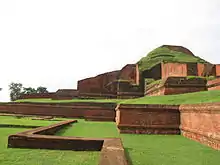Mughal architecture
Mughal architecture is the type of Indo-Islamic architecture developed by the Mughals in the 16th, 17th and 18th centuries throughout the ever-changing extent of their empire in the Indian subcontinent. It developed the styles of earlier Muslim dynasties in India as an amalgam of Islamic, Persian, Turkic and Indian architecture. Mughal buildings have a uniform pattern of structure and character, including large bulbous domes, slender minarets at the corners, massive halls, large vaulted gateways, and delicate ornamentation; Examples of the style can be found in modern-day India, Afghanistan, Bangladesh, and Pakistan.


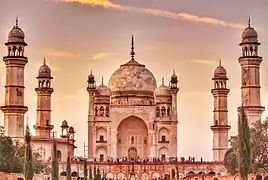
The Mughal dynasty was established after the victory of Babur at Panipat in 1526. During his five-year reign, Babur took considerable interest in erecting buildings, though few have survived. His grandson Akbar built widely, and the style developed vigorously during his reign. Among his accomplishments were Agra Fort, the fort-city of Fatehpur Sikri, and the Buland Darwaza. Akbar's son Jahangir commissioned the Shalimar Gardens in Kashmir.
Mughal architecture reached its zenith during the reign of Shah Jahan, who constructed Taj Mahal, the Jama Masjid, the Shalimar Gardens of Lahore, the Wazir Khan Mosque, and who renovated the Lahore Fort. The last of the great Mughal architects was Aurangzeb, who built the Badshahi Mosque. Mughal Inlay art is a remarkable feature of Mughal architecture in India and Inlay art was an instrument of dynamic expression in the great age of the Mughal Empire. The Monuments of Agra (India) provide the different stages of the development of Mughal Inlay art in a progressive sequence during sixteenth to seventeenth century as practiced under Akbar (r. 1556-1605), Jahangir (r. 1605-1627), and Shah Jahan (r. 1628-1658). This research paper will present probable aspects related to the origin and development of Mughal Inlay art. Marble inlay-‘Pachchikari’ or ‘Parchinkari’ is one of the most beautiful and popular forms of Mughal art developed indigenously in India. It is to be believed that it is typically Italian in origin and some contend it to be of the Indian origin itself. Inlay technically known as Pietra dura (Italian for "hard stone") is marble inlaid with designs in precious or semi-precious stonework. The present paper attempts to establish from written sources the possible interconnection between the inlay work during Jahangir period and its development. The Mughal Inlay art’s origin is in India and it developed indigenously as it relied on several key aspects. Ram Nath, Ebba Koch, E.W Smith, V.A. Smith and Major Kole explore some elements of the origin and development of inlay work. The findings show that it is not only an indigenous Indian art and but also that it developed rapidly during the reign of Jahangir. The points came from the visit of Jahangir in Mandu (India). When Jahangir visited Mandu, the fascinated inlay work there impressed him and as the continuous refinement of inlay work can be seen in the Jahangir buildings i.e. from Akbar’s Tomb to Salim Chisti’s Tomb and ultimately a remarkable change in the Tomb of Itmad-ud doulah. Mughal Inlay art is a remarkable feature of Mughal architecture in India and Inlay art was widely appreciated and debated with respect to its origin and development.[2]
Features

Mughal architecture incorporates Indian elements with Persian and Islamic elements. Some features common to many buildings are: Large bulbous onion domes, sometimes surrounded by four smaller domes.
- Use of white marble and red sandstone.
- Use of delicate ornamentation work, including pachin kari decorative work and jali-latticed screens.
- Monumental buildings surrounded by gardens on all four sides.
- Mosques with large courtyards.
- Persian and Arabic calligraphic inscriptions, including verses from the Quran.
- Large gateways leading up to the main building.
- Iwans on two or four sides.
- Use of decorative chhatris.
Mughal architecture has also influenced later Indian architectural styles, including the Indo-Saracenic style of the British Raj, the Rajput style and the Sikh style.
Monuments

Akbar
Agra Fort
Agra fort is a UNESCO world heritage site in Agra, Uttar Pradesh. The major part of Agra fort was built by Akbar from 1565 to 1574. The architecture of the fort clearly indicates the free adoption of the Rajput planning and construction. Some of the important buildings in the fort are Jahangiri Mahal built for Jahangir and his family, the Moti Masjid, and Mena Bazaars. The Jahangiri Mahal is an impressive structure and has a courtyard surrounded by double-storeyed halls and rooms.
Humayun's Tomb

Humayun's tomb is the tomb of the Mughal Emperor Humayun in Delhi, India. The tomb was commissioned by Humayun's first wife and chief consort, Empress Bega Begum (also known as Haji Begum), in 1569-70, and designed by Mirak Mirza Ghiyas and his son, Sayyid Muhammad, Persian made architects chosen by her. It was the first garden-tomb on the Indian subcontinent. It is often regarded as the first mature example of Mughal architecture.
Fatehpur Sikri
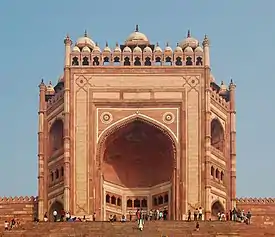
Akbar’s greatest architectural achievement was the construction of Fatehpur Sikri, his capital city near Agra at a trade and Jain pilgrimages.[3][4][5] The construction of the walled city was started in 1569 and completed in 1574.
It contained some of the most beautiful buildings – both religious and secular which testify to the Emperor’s aim of achieving social, political and religious integration. The main religious buildings were the huge Jama Masjid and small Tomb of Salim Chisti. Buland Darwaza, also known as the Gate of Magnificence, was built by Akbar in 1576 to commemorate his victory over Gujarat and the Deccan. It is 40 metres high and 50 metres from the ground. The total height of the structure is about 54 metres from ground level.
The Haramsara, the royal seraglio in Fatehpur Sikri was an area where the royal women lived. The opening to the Haramsara is from the Khwabgah side separated by a row of cloisters. According to Abul Fazl, in Ain-i-Akbari, the inside of Harem was guarded by senior and active women, outside the enclosure the eunuchs were placed, and at a proper distance there were faithful Rajput guards.[6]
Jodha Bai's Palace is the largest palace in the Fatehpur Sikri seraglio, connected to the minor haramsara quarters. The main entrance is double storied, projecting out of the facade to create a kind of porch leading into a recessed entrance with a balcony. Inside there is a quadrangle surrounded by rooms. The columns of rooms are ornamented with a variety of Hindu sculptural motifs.
Tomb of Salim Chisti
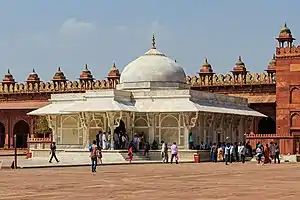
The Tomb of Salim Chishti is famed as one of the finest examples of Mughal architecture in India, built during the years 1580 and 1581. The tomb, built in 1571 in the corner of the mosque compound, is a square marble chamber with a verandah. The cenotaph has an exquisitely designed lattice screen around it. It enshrines the burial place of the Sufi saint, Salim Chisti (1478 – 1572), a descendant of Khwaja Moinuddin Chishti of Ajmer, who lived in a cavern on the ridge at Sikri. The mausoleum, constructed by Akbar as a mark of his respect for the Sufi saint, who foretold the birth of his son.
Begum Shahi Mosque
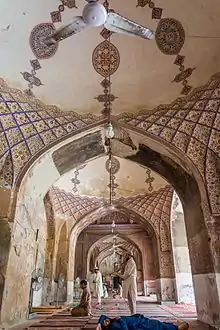
The Begum Shahi Mosque is an early 17th-century mosque situated in the Walled City of Lahore, Pakistan. The mosque was built between 1611 and 1614 during the reign of Mughal Emperor Jahangir in honour of his mother, and is Lahore's earliest surviving example of a Mughal-era mosque.[7][8] The mosque would later influence. construction of the larger Wazir Khan Mosque a few decades later.[9]
Tomb of I'timād-ud-Daulah
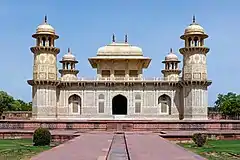
The tomb of I'timād-ud-Daulahmausoleum in the city of Agra in the Indian state of Uttar Pradesh. Often described as a "jewel box", sometimes called the "Bachcha Taj", as the tomb of I'timād-ud-Daulah is often regarded as a draft of the Taj Mahal.
Shah Jahan

Rather than building huge monuments like his predecessors to demonstrate their power, Shah Jahan built elegant monuments. The force and originality of this previous building style gave way under Shah Jahan to a delicate elegance and refinement of detail, illustrated in the palaces erected during his reign at Agra, Delhi and Lahore. Some examples include the Taj Mahal at Agra, the tomb of his wife Mumtaz Mahal. The Moti Masjid (Pearl Mosque) in the Agra Fort and the Jama Masjid at Delhi are imposing buildings of his era, and their position and architecture have been carefully considered so as to produce a pleasing effect and feeling of spacious elegance and well-balanced proportion of parts. Shah Jahan also renovated buildings such as the Moti Masjid, Sheesh Mahal and Naulakha pavilion, which are all enclosed in the Lahore Fort. He also built a mosque named after himself in Thatta called Shahjahan Mosque (not built in the Mughal architecture, but in Safavid and Timurid architecture that were influenced by the Persian architecture). Shah Jahan also built the Red Fort in his new capital at Shah Jahanabad, now Old Delhi. The red sandstone Red Fort is noted for its special buildings-Diwan-i-Aam and Diwan-i-Khas. Another mosque was built during his tenure in Lahore called Wazir Khan Mosque, by Shaikh Ilm-ud-din Ansari who was the court physician to the emperor. It is famous for its rich embellishment which covers almost every interior surface.
Taj Mahal
The Taj Mahal, a World Heritage Site was built between 1630–49 by the emperor Shah Jahan in memory of his wife Mumtaz Mahal.[1] Its construction took 22 years and required 22,000 laborers and 1,000 elephants, at a cost of 32 million rupees. (corresponding to US$ 827 million in 2015) It is a large, white marble structure standing on a square plinth and consists of a symmetrical building with an iwan (an arch-shaped doorway) topped by a large dome and finial.
The building's longest plane of symmetry runs through the entire complex except for the sarcophagus of Shah Jahan, which is placed off centre in the crypt room below the main floor. This symmetry is extended to the building of an entire mirror mosque in red sandstone, to complement the Mecca-facing mosque placed to the west of the main structure. Parchin kari, a method of decoration on a large scale-inlaid work of jewels and Jali work has been used to decorate the structure.
Wazir Khan Mosque
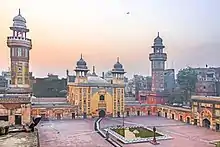
The Wazir Khan Mosque was commissioned during the reign of the Mughal Emperor Shah Jahan in 1634, and completed in 1642.[10] Considered to be the most ornately decorated Mughal-era mosque,[11] Wazir Khan Mosque is renowned for its intricate faience tile work known as kashi-kari, as well as its interior surfaces that are almost entirely embellished with elaborate Mughal-era frescoes. The mosque has been under extensive restoration since 2009 under the direction of the Aga Khan Trust for Culture and the Government of Punjab.[12]
Shalimar Gardens
_terrace_view_from_Farah_Baksh_(Bestower_of_Pleasure)_terrace.jpg.webp)
It is a Mughal garden complex located in Lahore, capital of the Pakistani province of Punjab. The gardens date from the period when the Mughal Empire was at its artistic and aesthetic zenith.[13] Construction of the gardens began in 1641 during the reign of Emperor Shah Jahan,[14] and was completed in 1642.[15] In 1981 the Shalimar Gardens were inscribed as a UNESCO World Heritage Site as they embody Mughal garden design at the apogee of its development.[13]
Shah Jahan Mosque

The Shah Jahan Mosque is the central mosque for the city of Thatta, in the Pakistani province of Sindh. The mosque commissioned by Shah Jahan, who bestowed it to the city as a token of gratitude.[16] Its style is heavily influenced by Central Asian Timurid architecture, which was introduced after Shah Jahan's campaigns near Balkh and Samarkand.[16] The mosque is considered to have the most elaborate display of tile work in South Asia,[16][17] and is also notable for its geometric brick work - a decorative element that is unusual for Mughal-period mosques.[7]
Shahi Hammam
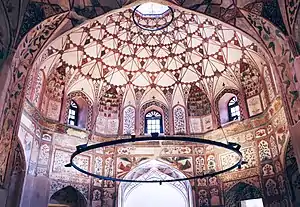
Shahi Hammam is a Persian-style bath which was built in Lahore, Pakistan, in 1635 C.E. during the reign of Emperor Shah Jahan. It was built by chief physician to the Mughal Court, Ilam-ud-din Ansari, who was widely known as Wazir Khan.[18][19][20] The baths were built to serve as a waqf, or endowment, for the maintenance of the Wazir Khan Mosque.[21]
Aurangzeb
In Aurangzeb's reign (1658–1707) squared stone and marble was replaced by brick or rubble with stucco ornament. Srirangapatna and Lucknow have examples of later Indo-Mughal architecture. He made additions to the Lahore Fort and also built one of the thirteen gates which were later named after him (Alamgir).
Badshahi Mosque
.jpg.webp)
The Badshahi Mosque in Lahore, Pakistan was commissioned by the sixth Mughal Emperor Aurangzeb. Constructed between 1671 and 1673, it was the largest mosque in the world upon construction. It is the third-largest mosque in Pakistan and the seventh-largest mosque in the world. The mosque is adjacent to the Lahore Fort and is the last in the series of congregational mosques in red sandstone. The red sandstone of the walls contrasts with the white marble of the domes and the subtle intarsia decoration. Aurangzeb's mosque's architectural plan is similar to that of his father, Shah Jahan, the Jama Masjid in Delhi; though it is much larger. It also functions as an idgah. The courtyard which spreads over 276,000 square feet, can accommodate one hundred thousand worshippers; ten thousand can be accommodated inside the mosque. The minarets are 196 feet (60 m) tall. The Mosque is one of the most famous Mughal structures but suffered greatly under the reign of Maharaja Ranjit Singh. In 1993, the Government of Pakistan included the Badshahi Mosque in the tentative list for UNESCO World Heritage Site.[22]
Additional monuments
Additional monuments from this period are associated with women from Aurangzeb's imperial family. The construction of the elegant Zinat al-Masjid in Daryaganj was overseen by Aurangzeb's second daughter Zinat-al-Nissa. Aurangzeb's sister Roshan-Ara who died in 1671. The tomb of Roshanara Begum and the garden surrounding it were neglected for a long time and are now in an advanced state of decay.
Bibi ka Maqbara
Bibi Ka Maqbara was a mausoleum built by Emperor Aurangzeb, in the late 17th century as a loving tribute to his first wife, Dilras Bano Begum in Aurangabad, Maharashtra. Some accounts suggest that later it was taken care by Azam Shah, son of aurangzeb. It is a replica of the Taj Mahal, and was designed by Ata-Ullah, the son of Ahmed Lahori, who was the principal designer of the Taj Mahal.
Lalbagh Fort
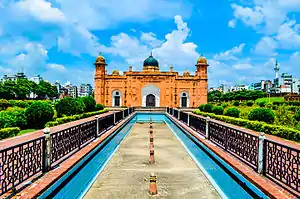
Lalbagh Fort (also known as "Fort Aurangabad"), a Mughal palace fortress at the Buriganga River in the southwestern part of Dhaka, Bangladesh, whose construction started in 1678 during the reign of Aurangzeb’s son Azam Shah.
Sunehri Mosque
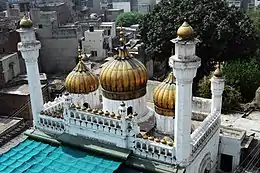
Sunehri Mosque is a late Mughal-era mosque in the Walled City of Lahore, Pakistan. Sunehri Mosque was built in 1753 when the empire was in decline, during the reign of Muhammad Shah.
Tomb of Safdar Jang
The Tomb of Safdar Jung completed in 1754 is one of the last examples of Mughal Architecture.
Mughal gardens

Mughal gardens are gardens built by the Mughals in the Islamic style. This style was influenced by Persian gardens. They are built in the char bagh structure, which is a quadrilateral garden layout based on the four gardens of Paradise mentioned in the Qur'an. This style is intended to create a representation of an earthly utopia in which humans co-exist in perfect harmony with all elements of nature.[23]
The quadrilateral garden is divided by walkways or flowing water into four smaller parts. Significant use of rectilinear layouts are made within the walled enclosures. Some of the typical features include pools, fountains and canals inside the gardens.
Some famous examples of Mughal gardens are the Bagh-e-Babur at Kabul, Mehtab Bagh gardens at the Taj Mahal, gardens at Humayun's Tomb, Shalimar Gardens at Lahore, Khusro Bagh at Prayagraj, as well as Pinjore Gardens at Haryana.
The ensemble of six Mughal Gardens of Jammu and Kashmir (Pari Mahal, Nishat Bagh, Shalimar Bagh, Chashme Shahi, Verinag Garden, Achabal Gardens) are on the tentative list of UNESCO World Heritage Sites in India.
Mughal bridges
Shahi Bridge, Jaunpur was constructed during the reign of the Mughal Emperor Akbar. Mughal Emperor Akbar ordered the construction of the Shahi Bridge, which was completed in the year 1568–69 by Munim Khan. It took four years to complete the bridge. It was designed by Afghan architect Afzal Ali.
Gallery
 The Darwaza-i-Rauza (Great Gate) of the Taj Mahal.
The Darwaza-i-Rauza (Great Gate) of the Taj Mahal.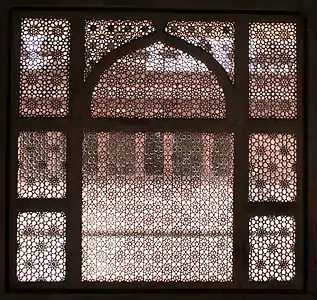
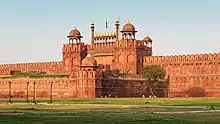

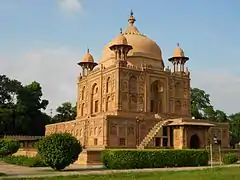 Tomb of Nithar Begum at Khusro Bagh, Allahabad, India.
Tomb of Nithar Begum at Khusro Bagh, Allahabad, India.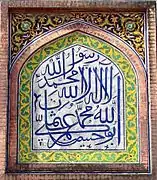
 Akbar's Tomb at Agra, India uses red sandstone and white marble, like many of the Mughal monuments. The Taj Mahal is a notable exception, as it uses only marble.
Akbar's Tomb at Agra, India uses red sandstone and white marble, like many of the Mughal monuments. The Taj Mahal is a notable exception, as it uses only marble..JPG.webp) Diwan-i-Khas (Hall of private audience) at Lahore Fort.
Diwan-i-Khas (Hall of private audience) at Lahore Fort..jpg.webp) Shah Jahan Mosque in Thatta, Pakistan. The mosque is not built in the Mughal style, but reflects a heavy Persian influence.
Shah Jahan Mosque in Thatta, Pakistan. The mosque is not built in the Mughal style, but reflects a heavy Persian influence.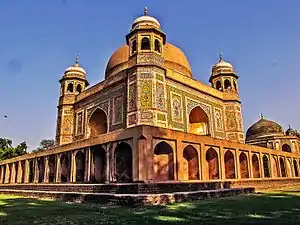 One of the Tombs of Ustad-Shagird, Nakodar, India.
One of the Tombs of Ustad-Shagird, Nakodar, India.
References
- "Taj Mahal World Heritage". UNESCO World Heritage. Centre. Archived from the original on 1 February 2019. Retrieved 31 December 2018.
- http://www.kgnmarbleinlay.com/blog-post-history-of-mughal-inlay.html
- Fatehpur Sikri was once a Jain pilgrimage centre: Book. Zee News. 27 February 2013.
- "Excavation at Akbars fort at Fatehpur Sikri reveals flourishing Jain and Hindu habitation". Retrieved 15 December 2017.
- "Fatehpur Sikri was once a Jain pilgrimage centre: Book". hindustantimes.com/. 27 February 2013. Retrieved 15 December 2017.
- Gupta, Fathepur Sikri:Akbar's Magnificent City on a Hill, pp. 146.
- Asher, Catherine (1992). Architecture of Mughal India, Part 1, Volume 4. Cambridge University Press. ISBN 9780521267281. Retrieved 16 July 2017.
- "Begum Shahi Masjid". Pakistan Today. 12 March 2016. Retrieved 31 August 2016.
- "The mosque that Jodha Bai built". Daily Times. 26 June 2004. Retrieved 5 June 2013.
- "Conservation of the Wazir Khan Mosque Lahore: Preliminary Report on Condition and Risk Assessment" (PDF). Aga Khan Development Network. 2012. Archived from the original (PDF) on 27 August 2016. Retrieved 25 August 2016.
The Wazir Khan Mosque was built in 1634-35 AD (1044-45 AH), by Hakim ’Ali ud din* a governor of Punjab in the early part of the reign of the Mughal emperor Shah Jahan.
- Masson, Vadim Mikhaĭlovich (2003). History of Civilizations of Central Asia: Development in contrast : from the sixteenth to the mid-nineteenth century. UNESCO. ISBN 9789231038761.
- "Walled city of Lahore conservation". Retrieved 25 August 2016.
The Walled city of Lahore is famous for several historic monuments including the Lahore Fort – a World Heritage site, the Badshahi, and Wazir Khan mosques. Close to 2,000 buildings within the Walled city display a range of architectural features that mark Lahore’s centuries-old cultural landscape. A majority of these buildings and the mohallas (local neighbourhoods) in which they are situated form a unique heritage footprint. The work consequently carried out by the Aga Khan Trust for Culture (A.K.T.C.) and the Aga Khan Historic Cities Programme (AKHCP) was initiated under a 2007 public-private partnership framework agreement with the Government of Punjab.
- "Fort and Shalimar Gardens in Lahore". UNESCO. Retrieved 4 January 2017.
- REHMAN, A. (2009). "Changing Concepts of Garden Design in Lahore from Mughal to Contemporary Times". Garden History. 37 (2): 205–217. JSTOR 27821596.
- Shalamar Gardens Gardens of the Mughal Empire. Retrieved 20 June 2012
- Khazeni, Arash (2014). Sky Blue Stone: The Turquoise Trade in World History. Univ of California Press. ISBN 9780520279070. Retrieved 16 July 2017.
- Centre, UNESCO World Heritage. "Shah Jahan Mosque, Thatta". UNESCO World Heritage Centre. Archived from the original on 3 October 2018. Retrieved 31 December 2018.
- Asher, p.225
- Shelomo Dov Goitein. Studies in Islamic History and Institutions BRILL, 2010 ISBN 9004179313 p 170
- "Masjid Vazir K̲h̲ān". Archnet. Retrieved 25 August 2016.
The mosque was founded by Hakim Ilmud Din Ansari, a distinguished physician from Chiniot who received the Ministerial title of 'Wazir Khan' under the reign of Shah Jahan, and was later promoted to the position of Viceroy of Punjab.
- {{cite web|title=History and Background in Conservation of the Wazir Khan Mosque Lahore: Preliminary Report on Condition and Risk Assessment.|url=http://archnet.org/publications/6586%7Cwebsite=Aga Khan Historic Cities Programme|publisher=Aga Khan Cultural Services - Pakistan|access-date=25 August 2016|date=2012|quote=The spectacular monumental ensemble of the Wazir Khan Mosque in the Walled City of Lahore was built in 1634 during the reign of the Mughal emperor Shah Jahan.
- UNESCO World Heritage Centre. "Badshahi Mosque, Lahore – UNESCO World Heritage Centre". Whc.unesco.org. Retrieved 2 January 2014.
- REHMAN, ABDUL (2009). "Changing Concepts of Garden Design in Lahore from Mughal to Contemporary Times". Garden History. 37 (2): 205–217. ISSN 0307-1243. JSTOR 27821596.
Sources
- Catherine Blanshard Asher. Architecture of Mughal India, Part 1, Volume 4. Cambridge University Press. ISBN 9780521267281.
- George Michell, Amit Pasricha (2011). Mughal Architecture & Gardens. ISBN 9781851496709.
- Gupta, Subhadra Sen; Irani, Prakash (2013). Fathepur Sikri: Akbar's Magnificent City on a Hill. ISBN 9789381523728.
- Marble Table Top History of Mughal Inlay
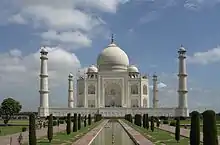
.jpg.webp)
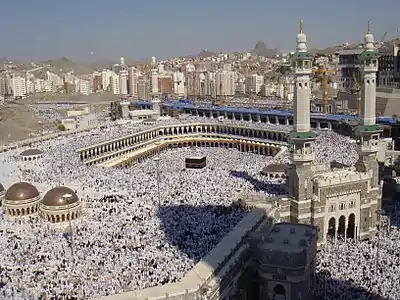
.jpeg.webp)
.jpg.webp)
